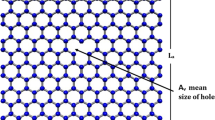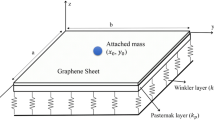Abstract
Present study peruses the vibrational behavior of triangular graphene sheets based on nano-mechanical graphene sensors. To this end, pristine and defected triangular graphene sheets in two directions, zigzag and armchair, have been simulated in molecular dynamic environment, and also the static response of sheets alone and with attached particles has been studied. By extracting the natural frequency using frequency decomposition method for sheets alone and with attached particles on them, as well as for defected sheets, their vibrational characteristics are determined and the frequency sensitivity is obtained for the number of different particles added. Two analyzes of mechanical tensile properties and vibrational properties have been performed to verify the accuracy of the method used on square and rectangular graphene sheets. Graphene sheet behavior under tensile test compared with other literature of molecular dynamic results and also the vibrational behavior of the square graphene sheet is obtained from the present method compared with the results of one of the improved theories of continuum mechanics. The comparisons illustrate the accuracy and applicability of the method is used. Finally, by examining the frequency sensitivity of each sheet, it is shown that equilateral triangular geometry in zigzag direction with the highest frequency sensitivity will result in sensors with higher sensitivity.

Graphical abstract

















Similar content being viewed by others
References
Ando T (2009) The electronic properties of graphene and carbon nanotubes. Npg Asia Mater 1:17–21
Ansari R, Sahmani S, Arash B (2010) Nonlocal plate model for free vibrations of single-layered graphene sheets. Phys Lett A 375:53–62
Bambill DV, La Malfa S, Rossit CA, Laura PAA (2004) Analytical and experimental investigation on transverse vibrations of solid, circular and annular plates carrying a concentrated mass at an arbitrary position with marine applications. Ocean Eng 31:127–138
Brack M, Blaschke J, Creagh SC, Magner AG, Meier P, Reimann SM (1997) On the role of classical orbits in mesoscopic electronic systems. Zeitschrift für Physik D Atoms, Molecules and Clusters 40:276–281
Brincker R, Zhang L, Andersen P (2000) Modal identification from ambient responses using frequency domain decomposition, pp 625–630
Castro Neto AH, Guinea F, Peres NMR, Novoselov KS, Geim AK (2009) The electronic properties of graphene. Rev Mod Phys 81:109–162
Foiles SM, Baskes MI, Daw MS (1986) Embedded-atom-method functions for the fcc metals Cu, Ag, Au, Ni, Pd, Pt, and their alloys. Phys Rev B 33:7983–7991
Gokus T, Nair RR, Bonetti A, Böhmler M, Lombardo A, Novoselov KS, Geim AK, Ferrari AC, Hartschuh A (2009) Making graphene luminescent by oxygen plasma treatment. ACS Nano 3:3963–3968
Gorman DJ (1986) Free vibration analysis of right triangular plates with combinations of clamped-simply supported boundary conditions. J Sound Vib 106:419–431
Heiskanen HP, Manninen M, Akola J (2008) Electronic structure of triangular, hexagonal and round graphene flakes near the Fermi level. New J Phys 10:103015
Jalali S, Kamal M, Naei H, Pugno NM (2014) Graphene-based resonant sensors for detection of ultra-fine nanoparticles: molecular dynamics and nonlocal elasticity investigations. Nano 10:1550024
Jalali SK, Jomehzadeh E, Pugno NM (2016) Influence of out-of-plane defects on vibration analysis of graphene: molecular dynamics and non-local elasticity approaches. Superlattice Microst 91:331–344
Kim CS, Dickinson SM (1990) The free flexural vibration of right triangular isotropic and orthotropic plates. J Sound Vib 141:291–311
Li Z, Zhang W, Luo Y, Yang J, Hou JG (2009) How graphene is cut upon oxidation? J Am Chem Soc 131:6320–6321
Liang Y, Han Q, Huan S (2015) The effects of temperature and vacancies on the elastic modulus and strength of graphene sheet. J Therm Stresses 38:926–933
Ma Y, Lehtinen PO, Foster AS, Nieminen RM (2004) Magnetic properties of vacancies in graphene and single-walled carbon nanotubes. New J Phys 6:68–68
Mirakhory M, Khatibi MM, Sadeghzadeh S (2018) Vibration analysis of defected and pristine triangular single-layer graphene nanosheets. Curr Appl Phys 18:1327–1337
Mohammadi M, Ghayour M, Farajpour A (2013) Free transverse vibration analysis of circular and annular graphene sheets with various boundary conditions using the nonlocal continuum plate model. Compos Part B 45:32–42
Mortazavi B, Fan Z, Pereira LFC, Harju A, Rabczuk T (2016) Amorphized graphene: a stiff material with low thermal conductivity. Carbon 103:318–326
Mousavi H, Khodadadi J (2014) Flake electrical conductivity of few-layer graphene. Sci World J 2014:6
Nakada K, Fujita M, Dresselhaus G, Dresselhaus MS (1996) Edge state in graphene ribbons: nanometer size effect and edge shape dependence. Phys Rev B 54:17954–17961
Natsuki T (2015) Theoretical analysis of vibration frequency of graphene sheets used as nanomechanical mass sensor. Electronics 4:723–738
Okada S (2008) Energetics of nanoscale graphene ribbons: edge geometries and electronic structures. Phys Rev B 77:041408
Peres NMR (2009) The electronic properties of graphene and its bilayer. Vacuum 83:1248–1252
Pradhan SC, Phadikar JK (2009) Nonlocal elasticity theory for vibration of nanoplates. J Sound Vib 325:206–223
Reimann SM, Manninen M (2002) Electronic structure of quantum dots. Rev Mod Phys 74:1283–1342
Rune B, Zhang L, Palle A (2001) Modal identification of output-only systems using frequency domain decomposition. Smart Mater Struct 10:441
Sadeghzadeh S (2016a) Equivalent mechanical boundary conditions for single layer graphene sheets. Micro Nano Lett 11:248–252
Sadeghzadeh S (2016b) Nanoparticle mass detection by single and multilayer graphene sheets: theory and simulations. Appl Math Model 40:7862–7879
Sadeghzadeh S (2017) The creation of racks and nanopores creation in various allotropes of boron due to the mechanical loads. Superlattice Microst 111:1145–1161
Sadeghzadeh S, Khatibi MM (2016) Effects of physical boundary conditions on the transverse vibration of single-layer graphene sheets. Appl Phys A 122:1–11
Sadeghzadeh S, Khatibi MM (2017) Modal identification of single layer graphene nano sheets from ambient responses using frequency domain decomposition. Eur J Mech A Solids 65:70–78
Sadeghzadeh S, Khatibi MM (2018) Vibrational modes and frequencies of borophene in comparison with graphene nanosheets. Superlattice Microst 117:271–282
Sadeghzadeh S, Rezapour N (2016a) The mechanical design of graphene nanodiodes and nanotransistors: geometry, temperature and strain effects. RSC Adv 6:86324–86333
Sadeghzadeh S, Rezapour N (2016b) A study of thermal conductivity in graphene diodes and transistors with intrinsic defects and subjected to metal impurities. Superlattice Microst 100:97–111
Sakhaee-Pour A, Ahmadian MT, Vafai A (2007) Application of single-layered graphene sheets as mass sensors and atomistic dust detectors, pp 99–104
Santana A, Popov AM, Bichoutskaia E (2013) Stability and dynamics of vacancy in graphene flakes: edge effects. Chem Phys Lett 557:80–87
Sun X, Zuoguang F, Xia M, Yuanjie X (2014) Effects of vacancy defect on the tensile behavior of graphene. Theor Appl Mech Lett 4:051002
Tersoff J (1990) Erratum: Modeling solid-state chemistry: interatomic potentials for multicomponent systems. Phys Rev B 41:3248–3248
Tsiamaki AS, Georgantzinos SK, Anifantis NK (2014) Monolayer graphene resonators for mass detection: a structural mechanics feasibility study. Sensors Actuators A Phys 217:29–38
Wang J, Tian M, He X, Tang Z (2014) Free vibration analysis of single-layered graphene sheets based on a continuum model. Appl Phys Front 2:1–7
Zhang Y, Zhang LW, Liew KM, Yu JL (2016) Free vibration analysis of bilayer graphene sheets subjected to in-plane magnetic fields. Compos Struct 144:86–95
Author information
Authors and Affiliations
Corresponding author
Ethics declarations
Conflict of interest
The authors declare that they have no conflict of interest.
Additional information
Publisher’s note
Springer Nature remains neutral with regard to jurisdictional claims in published maps and institutional affiliations.
Rights and permissions
About this article
Cite this article
Mirakhory, M., Khatibi, M.M. & Sadeghzadeh, S. Nanoparticle mass detection by single-layer triangular graphene sheets, the extraordinary geometry for detection of nanoparticles. J Nanopart Res 22, 159 (2020). https://doi.org/10.1007/s11051-020-04886-8
Received:
Accepted:
Published:
DOI: https://doi.org/10.1007/s11051-020-04886-8




